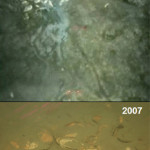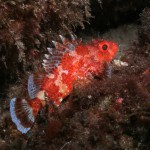![]() Researchers have been very concerned about the paucity of females of Vulcanoctopus hydrothermalis, an octopus inhabiting the hydrothermal vent community of the Eastern Pacific Rise. One senior, conservative squid researcher even went so far as to comment that this octopus was some part of a “queer spineless agenda.” Others scoffed at his remarks and asked for a “civil union” between the fighting factions of cephalopodologists.
Researchers have been very concerned about the paucity of females of Vulcanoctopus hydrothermalis, an octopus inhabiting the hydrothermal vent community of the Eastern Pacific Rise. One senior, conservative squid researcher even went so far as to comment that this octopus was some part of a “queer spineless agenda.” Others scoffed at his remarks and asked for a “civil union” between the fighting factions of cephalopodologists.
Finally, after hundreds of ten years, the mystery has been solved. A single female Vulcanoctopus was captured in 2004 and 4 years later has been described by González and colleagues in the latest issue of the Journal of the Marine Biological Association of the U.K.
 There she is, isn’t she pretty? A gorgeous specimen of the female sex if you ask me, or any of the several dozen male octopuses that have been discovered thus far. She looks much like the boys, but with a pear-shaped ovary. Interestingly, this female also lacks a specialized anatomical feature, called a spermatheca, that stores spermatophores, packets of the male’s sperm. Spermathecae are common in octopus. Since this specimen appeared to in a maturing phase, fertilization is still unknown in the species.
There she is, isn’t she pretty? A gorgeous specimen of the female sex if you ask me, or any of the several dozen male octopuses that have been discovered thus far. She looks much like the boys, but with a pear-shaped ovary. Interestingly, this female also lacks a specialized anatomical feature, called a spermatheca, that stores spermatophores, packets of the male’s sperm. Spermathecae are common in octopus. Since this specimen appeared to in a maturing phase, fertilization is still unknown in the species.
 In previous reports of the males, there were typically a high incidence of parasitism by the copepod Genesis vulcanoctopusi (picture from Lopez-Gonzalez et al. 2000). This female exhibited no evidence parasitism, evidences on males by visible cysts covering the mantle. So at least one female was STD free!
In previous reports of the males, there were typically a high incidence of parasitism by the copepod Genesis vulcanoctopusi (picture from Lopez-Gonzalez et al. 2000). This female exhibited no evidence parasitism, evidences on males by visible cysts covering the mantle. So at least one female was STD free!
———————————————————————
González, A., Guerra, A., Pascual, S., Segonzac, M. (2008). Female description of the hydrothermal vent cephalopod Vulcanoctopus hydrothermalis. Journal of the Marine Biological Association of the UK, 88(02) DOI: 10.1017/S0025315408000647
Lopez-Gonzalez, P.J., Bresciani, K., Huys, R., Gonzalez, A.F., Guerra, A. & Pascual, S. (2000) Description of Genesis vulcanoctopusi gen. et. sp. nov. (Copepoda: Tisbidae) parasitic on a hydrothermal vent octopod and a reinterpretation of the life cycle of cholidyinid parpacticoids. Cahiers Biologie Marine, 41, 241-253.





